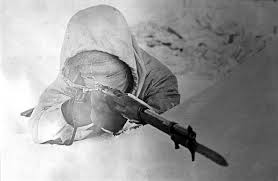You may be the type of hunter who insists on using iron sights, but for those of us who've left the stone age, holographic sights are a popular choice.
We’re kidding. We know there’s a time and place for iron sights... It’s called the iron age, and it happened around the year 1100 B.C. Kidding again.
In all seriousness—a good set of optics allows you to quickly get on target and fire rapidly and accurately. Many people opt for a telescopic or reflex sight, but today we'll focus on the advantages of holographic sights.
History of the holographic sight
First developed under contract with the U.S. Military in the 1970s for use on helicopter gunships, holographic sights have come a long way to being a common piece of hunting gear today.
The science behind holography (and therefore holo sights) goes back to the 1950s, with Hungarian-British scientist Dennis Gabor discovering a connection between synthetic radar and holograms. To give you a brief summary: he did some smart science stuff which we won’t bore you with, won a Nobel Prize, and paved the way for your modern-day tactical and hunting gear.
Fast forward a couple decades, and holographic optics had begun to make its way into military applications. Technology at the time of their invention meant that they were too bulky for use on small arms platforms. By the 80s, holographic heads-up displays (HUD) were deployed in fighter aircraft.
In 1996, EOTech released the first consumer holographic sight, designed for sport shooting and hunting. Advanced production methods developed since then have allowed prices to drop, making them attainable for the average hunter.
Holographic sights vs. reflex sights
Unlike reflex sights, holographic sights do not project the reticle directly in front of your eyes. Holo sights project a hologram between you and the target, allowing for a better view. Holo sights also provide better performance in terms of parallax distortion and glare compared to reflex.
The premier models of holo sights like those made by EOTech are often marketed as “operator-grade.” That term is somewhat of a buzz phrase, but they are undeniably high-end optics. For prices upwards of $500, you’ll find features like night vision, magnifiers, and multiple day and night-time settings.
The price of these optics may not be justifiable for the beginner or average hunter. However, those willing to splash the cash will likely find they provide superior clarity and field of view, and hold their zero well even in the clumsiest of hands.
On the other hand, reflex sights are generally cheaper, smaller, and have better battery life. These attributes vary greatly between individual optics, so comparing them one-on-one is important.
Here's an example of a holographic optic we love:
Vortex AMG UH-1 GEN II Holographic Sight
As the first manufacturer of consumer holo optics, EOTech has long dominated the market. However, new players like Vortex have recently entered the scene with some impressive offerings to challenge them in terms of quality and value.
Vortex’s AMG UH-1 Gen 2 is a higher-end sight (retailing at around $899). While certainly not the cheapest, its price tag is easily justified by its performance, lightning-quick reticle, and night vision features.
The UH-1 has four night-vision settings, a dedicated night vision button, 15 brightness settings, and solid battery life, making it a great choice for close- to mid-range shooting. For longer range hunting, it’s also compatible with magnifier attachments.
As for red dot sights, here’s a solid choice for a mid-market reflex:
Northtac Ronin M10 Red Dot Sight
Northtac's Ronin M10 is an affordable red dot sight, sitting in the middle range of the market. It features 12 brightness settings, auto-shutoff, and shake activation allowing for quick target acquisition.
While this sight doesn’t offer some of the features of higher-end models like night vision, its great battery life (50,000 hours) and lightweight, easy-to-use build make it a solid choice.
Are holographic sights worth it?
We know what you're thinking: get to the point—are holographic sights worth it? The answer to that is, well, it depends. It depends mostly on you: your budget, ability level, and goals.
Choosing the best holographic sight (or opting for a quality reflex sight) from the get-go can save you a lot of time and frustration in the long run, so it's best to take the time to research which one best fits your rifle and needs.
If you're a relatively inexperienced hunter, then a holographic sight may be overkill considering the price. That being said, they do provide an undeniably better field of view.
Remember, your hunting gear is only part of the equation. Even the best holographic sight won't go far in the hands of an improperly trained hunter. So whether you go for the high-end holo sight or instead spend that budget on hiring a trainer, we hope this information helps you next hunting season.



%201.svg)









